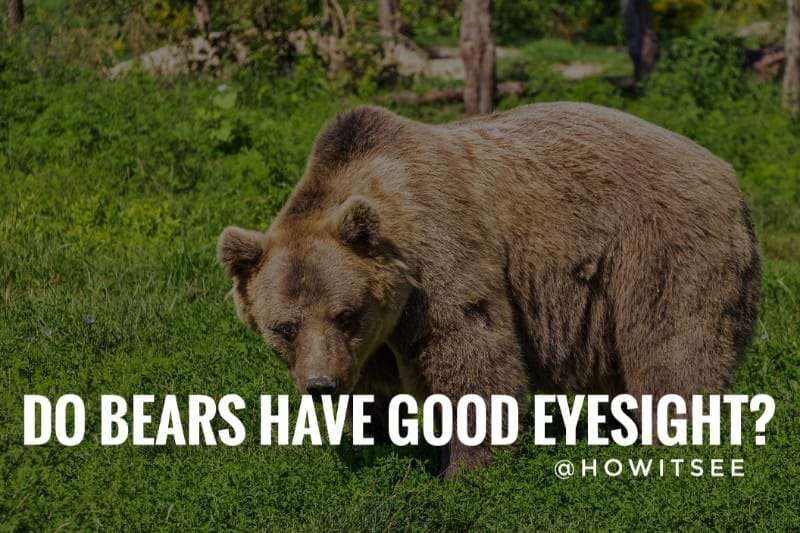Bears are classified as caniforms of the family Ursidae. They are also considered one of the most dangerous omnivorous mammals.
So, have you ever wondered how they see you or how good their eyesight is? So, if you have queries on bears’ vision, then this post is best for you.
The answer to the question, “Do Bears have good eyesight” is: Most bears have excellent eyesight as similar as humans. However, there is quite a bit of variation, and it leans on their species, age, and other factors. Example: Adult Polar Bears have the best eyesight and can see most of the colors like us. Bears generally glimpse the world with details and colors (with the most sensitivity towards blue and green).
But they mainly depend on their nose for navigation, tracking food, and other day-to-day activities. That’s is why the myth was raised that beers have poor eyesight. But it’s not true. Later in this post, we have discussed much in detail. So, let’s begin.
Do Bears have Good Eyesight?
A recent study shows bears have excellent eyesight with clear and color vision. They sense the world as same as humans. However, the variation depends on their age and species, like older bears have degraded vision whereas young or adult bears have dominant eyesight.
According to the research done at the University of Georgia and the University of Washington, it is found that most bears have the equivalent eyesight as humans up to a certain distance.
Also, bears have supremacy over humans in terms of night vision, field of view, and underwater vision. Bears have tapetum lucidum (a reflective layer) that allows them to see precisely at night.
Not only this, Polar bears have a transparent inner “eyelid” called a nictitating membrane that shields their eyes and enables them to hunt underwater like other marine mammals.
Bears’ eyes are positioned more towards the front of the head, granting them the binocular vision of a 120-degree field of view to read the depth of the environment.
Hence, it helps them to perceive the world in 3D view and calculate the distance between objects.
In the past, there was a myth that bears had poor eyesight. It is because bears’ keenest sense is their smell.
They can sense humans, other animals, food, etc., from a very far with their smell. That’s why they mostly rely on smell to overcome daily challenges.
Also, bears usually avoid prolonged eye contact because, for them, it is a display of aggression and can lead to conflict.
Are Bears colorblind?
Most bears, like Polar bears, can see and differentiate colors. However, American black bears have color vision shifted towards blue and green wavelengths.
It is not proven yet that Black bears can see red shades or not. If yes, then they can also distinguish millions of color shades like humans.
It’s true that dominantly bears rely on their smell rather than vision. Therefore, it is challenging to prove what colors bears can notice.

Source: BC SPCA
But unlike deer that are dichromats and cannot perceive long-wavelength shades, bears have much better vision. You can also differentiate them by reading the article below on deer vision in detail.
Also, it is noticed that bears fulfill their maximum of diet from colored berries and fruits. So, to distinguish them, they need a color sense.
Can Bears see color?
Yes, bears can see color mostly at small (blue) and medium (green) range wavelength. Some studies demonstrate that bears, like Polar Bears, can perceive colors of all three wavelengths from the visible spectrum (blue, green, and red).
Research is concluded by researchers Ellis Bacon and Gordon Burghardt of the University of Tennessee, where two bears are trained to identify blue and green from any other color shades efficiently. It flaunts that they can detect different shades of color.
Also, bears are nearsighted and have difficulty identifying entities at a distance, unlike humans. Here, we have only advantage over bears in terms of vision.
Can Bears see in the Dark?
Bears can see in the dark with the help of a reflective layer lining at the back of their eyeball called the tapetum lucidum.
The work of tapetum lucidum is to reflect back very dim light through the retina, allowing them to enhance the brightness of their vision.
Most nocturnal animals have tapetum lucidum. However, bears’ tapetum is slightly well developed than most animals. It helps them to navigate and search for their food in the dark, dense forests. Many predators from Cat families have the same reflective tissue that helps to hunt in the dark.

Source | OutdoorHub
Along with tapetum lucidum, bears have ten times more rods in their eyes as compared to humans. The rods help to collect even the slightest of light.
There are two types of photoreceptors in the retina: cones and rods.
Cones are responsible for color vision, and rods help to sense the light. In the cones, humans have the upper hand over most bear species; that’s why we can see millions of color shades.
However, based on the rods, every bear can easily surpass us. Nearly all bears have the night vision and can witness the world much better than humans during the night. Therefore it is always advised to keep your pets indoors at night.
How do Bears see the world?
Bears see the world at least as similar as humans but in different color contrasts. However, how bears perceive their surroundings is totally dependent on their species and age.
Many experiments indicated that maybe they grasp all three colors, red, green, and blue. And some revolved around that their eyes are only sensitive to blues and greens.
Bears can be trichromatic or dichromatic, depending on their species. Among all bears, Polar Bears have much better eyesight and witness the world nearly the same as humans with clarity.
Normally, bears have eyesight similar to many predators from Cat Families that assists in tracking and taking down their prey.
Also, it is confirmed that they glimpse the world much better than deer or other herbivore animals.
In addition, bears are nearsighted and have a clear vision. However, they are most dependable on their smell rather than their vision. Yes, it has been researched that bears rely more on their advanced smell to track or navigate their prey.
They are far better than nearly all known animals in terms of smell. Many sources claim that, on average, a black bear can smell food from over two miles away. In this way, you can estimate how best their sense of smell is.
Bear vision vs Human vision
| Bear Vision | Human Vision |
| Have tapetum lucidum allows them to see at night | Cannot see at night |
| Have a nictitating membrane allows them to see underwater | Does not have a nictitating membrane |
| Are sensitive towards blues, and greens | Are sensitive towards blues, greens, and reds |
Do Brown Bears attack humans?
According to the various investigations, brown bears hardly ever attack humans during an encounter. Maximum of time they avoid them or run of us.
However, it is still unpredictable when or how they attack. Usually, the probability increases when they feel insecure, threatened, or with their children.
Here, we conclude our article on “Do Bears have good eyesight” along with other queries. Also, this article is only for knowledge-sharing purposes. We hope you like it. We will be back with another post. Till then, stay tuned with us and read the articles below.
Frequently Asked Questions-
Q1. Do Polar Bears have good eyesight?
Ans. Yes, Polar Bears have the best eyesight among bears.
Q2. Do Grizzly Bears have good eyesight?
Ans. Yes, Grizzly Bears have good eyesight and can clearly perceive the world with colors.
Q3. Are Bears attracted to certain colors?
Ans. Most bears can recognize various colors, and sometimes they are attracted to bright colors in curiosity.
References-
Eyes of the Bear by Alaska Department of Fish and Game
Wikipedia
Also Read:

Meet Abhidept (nickname Monty), the visionary founder of How It See, being an engineering student, he’s fueled by an insatiable curiosity about the world around him. He is captivated by an eclectic correlation between animal groups, science, and nature, and this fascination drives his quest for understanding.
After completing his degree, he’s set on a mission to delve deep into the realm of nature, accumulating knowledge to share with you through his writing. In the meantime, he loves to watch anime and read anime.
